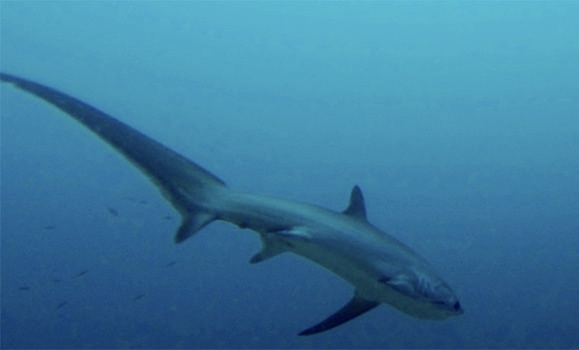A male thresher shark washed up on Crystal Crescent Beach this week, just outside of central Halifax. The shark was discovered by beachgoers Tuesday night and brought to the attention of Dalhousie Veterinarian Chris Harvey-Clark by the Department of Natural Resources.
Dr. Harvey-Clark was thrilled about the discovery.
“It’s quite exciting… [there are] not too many records of this type of shark.”
A rare find
Thresher sharks, known for their long tails — which can be as long as the shark itself — like warm water and are most commonly found in tropical zones globally. The particular species discovered this week is a big-eyed thresher shark (Alopias superciliosus), characterized by large eyes that can rotate upwards and are adapted to hunt in low-light, pelagic zones. They are quite uncommon in Canadian waters.
Big-eyed thresher sharks are listed as “vulnerable” by the International Union for the Conservation of Nature (IUCN) due to their limited capacity to recover from moderate exploitation.
 “Some threshers are visitors — they’re not common by any means,” says Dr. Harvey-Clark. “There are records, but they’re not something you see an awful lot of. Most people would never see one in their lives outside of fishermen.”
“Some threshers are visitors — they’re not common by any means,” says Dr. Harvey-Clark. “There are records, but they’re not something you see an awful lot of. Most people would never see one in their lives outside of fishermen.”
An opportunity for students
The specimen provided a unique opportunity for Dalhousie Biology students to learn about thresher sharks. With the shark’s arrival to the Dalhousie Biology Department, Dr. Harvey-Clark jumped at the chance to perform a dissection for students of the Dalhousie shark class.
“Anything beachcast is usually rotten, but this guy is in lovely shape to study its anatomy. Common threshers are not that common. But this one, it’s a rare species, it’s terribly exciting for students to see something rare and so intact. All the structures are there; we’re able to tell a full story.”
Thresher sharks, also known as long-tailed sharks, use their caudal (tail) fin to slap and stun smaller prey fish. “The anatomy of how they do that isn’t well described,” says Dr. Harvey-Clark. “It’s fascinating to be able to figure out the biomechanics of this shark using its strong dorsal muscles like a whip.”
Understanding sharks
The shark was likely hooked by an offshore pelagic longliner vessel catching tuna or other large open-sea commercial species. Deep-sea longlines are the second most common cause of shark mortality next to gillnet fishing, and represent a significant risk to many overexploited shark species globally.
“Sharks are here, they’re offshore not inshore for the most part,” says Dr. Harvey-Clark. Sharks are long-lived and have slow reproduction rates.
“There used to be so many other shark species around here. These animals are becoming scarce for a number of reasons, fishing becoming one of them. Their conservation is an extremely important research question, and needs a research answer.”

